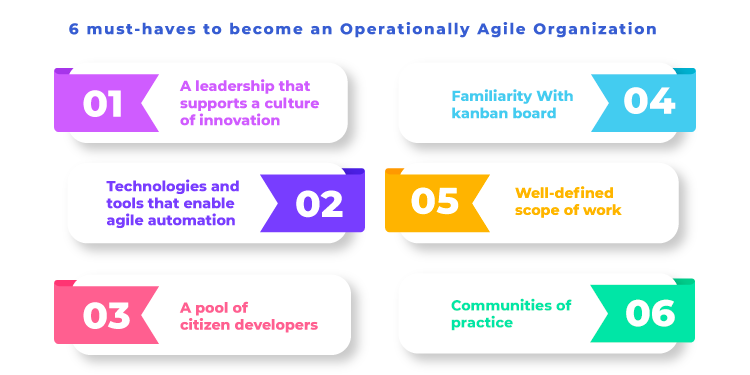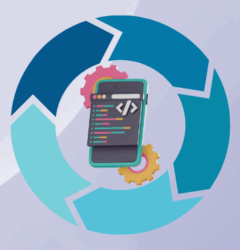
This article was first published on ITProPortal
Digital acceleration and digital disruption were the buzz phrases in the pre-pandemic times, but now they have become the living necessities for organizations across the world. Business models are getting modified or even replaced to find that sweet spot between existing capabilities and future expectations. There is a prominent need for organizations to evolve the way their business and technical teams operate and innovate. They can do so by working towards achieving operational agility across their setup.
The need of the hour is to be creative with technology and address evolving business requirements with custom-made applications. Organizations should develop operational and strategic agility to:
- Handle business turbulence triggered by market dynamics, competitive pressures, and natural calamities like COVID-19
- Encourage innovative problem-solving
- Effectively manage incremental changes
- Achieve rapid innovation cycles
- Assess risk and strategies to mitigate adverse outcomes
Before jumping on the bandwagon of operational agility, organizations need to do their homework and tick some boxes to avoid any hiccups during the transition.
6 must-haves to become Operationally Agile
We have compiled a list of six must-haves that organizations must consider:

1. A leadership that supports a culture of innovation
Any kind of cultural shift in an organization begins from the top. The first step in achieving operational agility is to articulate agile philosophy for the workforce, and able leadership teams do that without fail. More than telling the enterprising stories of innovation, it’s about showing the value of an agile workforce and how it can enable organizations to work their way through evolving technologies, operations, and business requirements – to keep initiating innovative projects and adapting to the changes of tomorrow.
2. Technologies and tools that enable agile automation
Operational agility is not only about automating manual processes but automating them in an agile, responsive, and time-effective manner by leveraging the right kind of technologies and tools. It’s not wise to automate everything in one go and different departments such as HR marketing, sales, or finance should identify critical processes that require immediate automation and build customized enterprise-grade applications using drag-and-drop no-code platforms like Quixy.
The idea is to enable non-technical teams to build priority-specific applications all by themselves, without writing a single line of code (hence the name no-code), and therefore, reducing their dependency on the IT resources. On the other hand, technical teams can get away from the unproductive cycle of fixing minor glitches and focus more on complex applications and larger strategic initiatives.
3. A pool of citizen developers
To become operationally agile, organizations can’t put the entire onus on their in-house or outsourced technical teams, and employees from diverse domains need to step up. They can become practitioners of no-code platforms and channel their problem-solving skills to build applications for mission-critical priorities without any external help. In other words, they can become citizen developers and enjoy a certain autonomy. This sense of responsibility and value can empower non-technical individuals across the organization, thereby creating a conducive environment for rapid development and innovation.
Citizen development provides individuals an opportunity to be creative with technology, even if they can’t write code. This fosters inclusivity at a workplace, where employees from different domains can turn their enterprising ideas or concepts into practical and customer-centric applications.
Also read: Business-Led IT is crucial for your Business Success: Here’s Why!
4. Familiarity with kanban board
A bulk part of IT operations isn’t physical in nature and can’t be visualized like line assembly items. Therefore, to spot bottlenecks and improve the flow of work, cross-functional teams can use a Kanban board – an agile project management tool.
It gives team members a bird’s eye view of the suggested ideas, tasks that are yet to begin, and work-in-progress items with the help of visual cards and columns.
5. Well-defined scope of work
Achieving operational agility should be a joint effort and before adding an agility layer to an organization, it is important to develop trust among IT and business teams. The best way is to have a well-defined scope of work and permissions for each team. This way there won’t be any overlapping of responsibilities or accountabilities in case of cross-functional projects or even otherwise.
6. Communities of practice
Wikipedia defines communities of practice as – a group of people (both technical and non-technical) who “share a concern or a passion for something they do and learn how to do it better as they interact regularly.”
Collaboration and cross-functional coherence are the backbone of operational agility and Communities of practice encourage both these aspects in an organization. It promotes knowledge-sharing among technical and non-technical teams and helps them establish best practices and understand each others’ plans for future innovations. For example – business teams can talk about their plans to leverage no-code platforms to build bespoke applications and curtail their reliance on technical personnel. This can allow IT leaders to prudently allocate their resources and cut down the existing backlog.
Organizations can have communities of practice for different areas of interest, such as operations, development, information security, regulatory compliance, and others. To derive optimum results, the leadership team should discuss the objectives of the group and ensure regular meetings and brainstorming sessions for the involved parties.

Summary
In the age of digital disruption, the pertinent questions for organizations are- to overcome or not to overcome? To innovate or not to innovate? To be agile or not to be agile? If the answer is yes, then it is high time that organizations built digital transformation capabilities, by leveraging technologies like no-code. It is high time they empowered functions besides IT, to turn them into self-sufficient centers of innovation and development.
Subscribe
Login
Please login to comment
0 Comments
Oldest
















